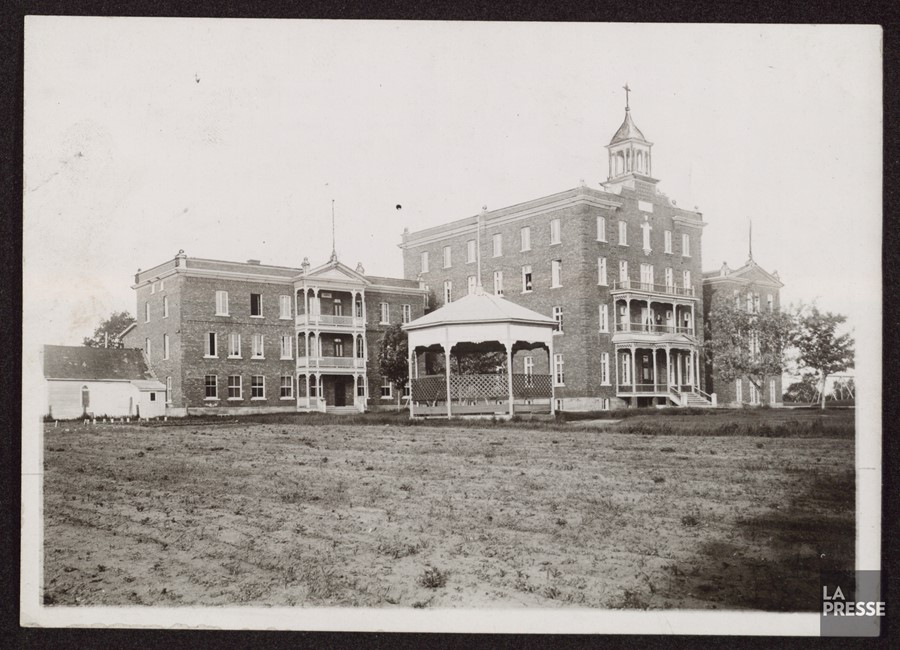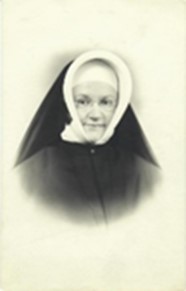The Great Story of the Convent of the Sisters of Saint Anne in Rawdon!
It was in 1865 that two nuns from the Congregation of the Sisters of Saint Anne (1) arrived in Rawdon. It was reportedly at the request of the clergy, Father Hercule-Thomas Clément, that the Congregation agreed to send Sister Marie-Xavier and Sister Marie-Mathilde to teach young girls. The convent started as an elementary school, with high school subsequently being added. The introduction of the bilingual business course was the main factor that contributed to the school’s great reputation in Quebec, across Canada and in New England, as was the case for Saint Anselm College at the same time (now the Collège Champagneur, also located on Queen Street).
A bit of history
It should be recalled that the Sisters of Saint Anne first came to Rawdon in 1865 very modestly. When they arrived, they settled in a house that the Congregation had obtained from Richard-Edward Corcoran in exchange for the education and accommodation of his two daughters. (2) A few months later, after the house burned down, the two nuns had to return to Saint-Jacques (3) but only for a few months, as in 1866, they came back to live in an old house lent by Alexander Daly. It was located at the end of 6rd Avenue. At that time, the school had some 15 students, including 5 boarders. It was on a pastoral visit that Bishop Bourget closed the dilapidated school and obliged Father J. Octave Rémillard to see about prioritizing the construction of a real convent for the sisters and hold collections in his parish and the surrounding area. (4)
The real origins of the convent
It could therefore be said that the real origins of the Convent of the Sisters of Saint Anne date back to 1867, when it was built on a site facing the Catholic Church on Queen Street provided by the Saint Patrick Parish Council. This new convent was built by Charles Magnan for the sum of $4,000. The convent welcomed 25 students and 2 nuns.
The convent continued to attract a clientele drawn by its reputation as a rare bilingual convent offering very high-quality training.
By 1902, the convent was welcoming more and more students (126 students for 10 nuns). Given its rapid and remarkable growth, the convent had to be extended again. This time, a three-storey wooden annex was built.
That was followed by a second annex in 1921, and all the exterior walls were covered with red bricks.
It was in 1938 that the English business course started to be offered, allowing the convent to recruit girls from several regions across Quebec. Over all these years, this educational institution trained many students, whether through the English business course or through the regular high school program with intensive English instruction.
As such, over all these years, with the purchase of the neighbouring lands and the completion of all these improvements, the nuns were able to carry out some changes not only to make the building more functional as a learning institution but also to promote the architectural beauty and attractive landscaping.
A page is turned
After the resale of the residence and following significant extension and renovation work, the Résidence Sainte-Anne remained a retirement home. A major fire in 2021 destroyed the entire central part, which was the oldest part of the convent.
It was in early 2024 that the new construction was completed, making the building an imposing residential complex for independent and semi-independent seniors. It is important to note that the new residence largely preserved the remarkable architecture of the former Saint Anne Convent, with its wooden music kiosk and the statue of Saint Anne.
A description of the architecture of the convent in 1882 is available on the site of the Résidence Sainte-Anne où on explique que l’édifice était de style Second Empire et comprenait, à l’origine, un bâtiment principal, un toit en tôle canadienne, une vaste galerie et un balcon, un clocher surmonté d’une horloge ainsi que des lucarnes circulaires. »
- “…the Congregation of the Sisters of Saint Anne is a typically Quebec establishment. The Congregation was founded in 1850 in Vaudreuil by Esther Blondin, with the main goal of alleviating the pitiable conditions of the rural schools at that time. All regions of Quebec, French-speaking Canada, New England and subsequently mission countries would benefit from the teachings of the Sisters of Saint Anne. Marie-Esther Sureau, also known as Blondin, the foundress of the Congregation, was beatified Blessed Mother Marie-Anne on April 29, 2001, by Pope John Paul II.” [translation] Source: : Un siècle de vie scolaire à Val-David, by Paul Carle
- The two daughters of Richard Corcoran who were part of the first 15 girls to study with the Sisters of Saint Anne also became nuns of Saint Anne.
- The Sisters of Saint Anne had already been well established in the surrounding area since 1853, thanks to Father Paré of Saint-Jacques who had given them a convent.
- In 1866, the house lent to the nuns by Alexandre Daly was so dilapidated that it was ironically dubbed “Le Château” [the castle].
- In 1987, the first owners of the retirement home were Laura and Charles Desrosiers. According to Mrs. Desrosiers, it was called the Manoir Desrosiers. They were the owners for a short time and lived there with their two children. She added: “We had more buyers than clients! A few nuns were among our residents. It was a huge amount of work for us…” [translation] She has handed over all the drawings and various documents of the residence to the Municipality of Rawdon.
Sources
- Rawdon : 175 ans d’histoire (1799-1974), Marcel Fournier, pp. 141 to 168
- Une bien belle histoire, 1837-1987 / Rawdon: A Human Mosaic, 1837-1987, Gérard Brady, pp. 167 to 172
- Histoire des Sœurs de Sainte-Anne : les premiers cinquante ans, 1850-1900: BAnQ numérique, pp. 169 to 171
- Rawdon History.com
- Up to Rawdon/Daniel Parkinson, pages 1139-1140 et mises à jour (Updates – Text + Photo)
- Photo of the students: BAnQ numérique, https://numerique.banq.qc.ca/patrimoine/details/52327/2071075?docsearchtext=rawdon
- Saint Anne Convent, four storeys, two annexes and music kiosk: BAnQ numérique,
https://numerique.banq.qc.ca/patrimoine/details/52327/4164337?docref=Gt26TPmzPnyX2UvaaqxFcA
- Model of the Résidence Sainte-Anne: https://residence-ste-anne.com/a-propos
- Photo of Sister Gabrielle-de-Jésus: Michel Léonard, private collection
Did you know that...
In the 1950s, the school board paid the tuition fees of the young girls who attended the Saint Anne Convent in 8rd and 9rd grades: $10 per month. However, for the boys who attended the Collège Champagneur, the board paid $15 per month.
Over 100 years (from 1865 to 1965), 14,195 students attended the convent, of which 662 obtained their public education diploma and 560 obtained their English business course diploma.
Some 15 young girls from the Rawdon Parish became nuns with the Sisters of Saint Anne. To our knowledge to date, they are:
- Mary Lane, Sister Marie-de-la-Conception (1858-1915), elder daughter of Thomas Lane. She worked in Western Canada for 57 years.
- Thérèsa Daly- (1869-1923), Sister Marie-Béatrice, who also worked in Western Canada for 26 years.
- Elisabeth Rowan (1872-1901), Sister Marie-Anne-de-Jésus, who lived for 27 years, including 14 as provincial of the houses in Western Canada.
- Madeleine Perreault (1939-1997), Sister Marie-Louise Madeleine.
- Ida Rivest (1946-2006), Sister Marie-Rolland-de-la-Croix.
- Suzanne Charbonneau (1947-2012), Sister Marie-Jean-Benoît.
- Marielle Lacasse (1947-2013), Sister Marie-Pierre-de-Galilée.
- Clémence Rivest (1949-1973), Sister Marie-André-de-Sienne.
- Aline Rivest (1949-2004), Sister Marie-Reine Aline.
- Claire Brousseau (1956-2000), Sister Marie-Léon-du-Sauveur.
- Lorette Lane (1959 …), Sister Marie-du-Cœur-de-Jésus.
- Cécile Chevrette (1962 …), Sister Marie-Lucie-de-la-Trinité.
- Monique Pelletier (1962 …), Sister Monique-du-Cœur-de-Marie.
- Denise Breault (1963 …), Sister Reine-Maria.






